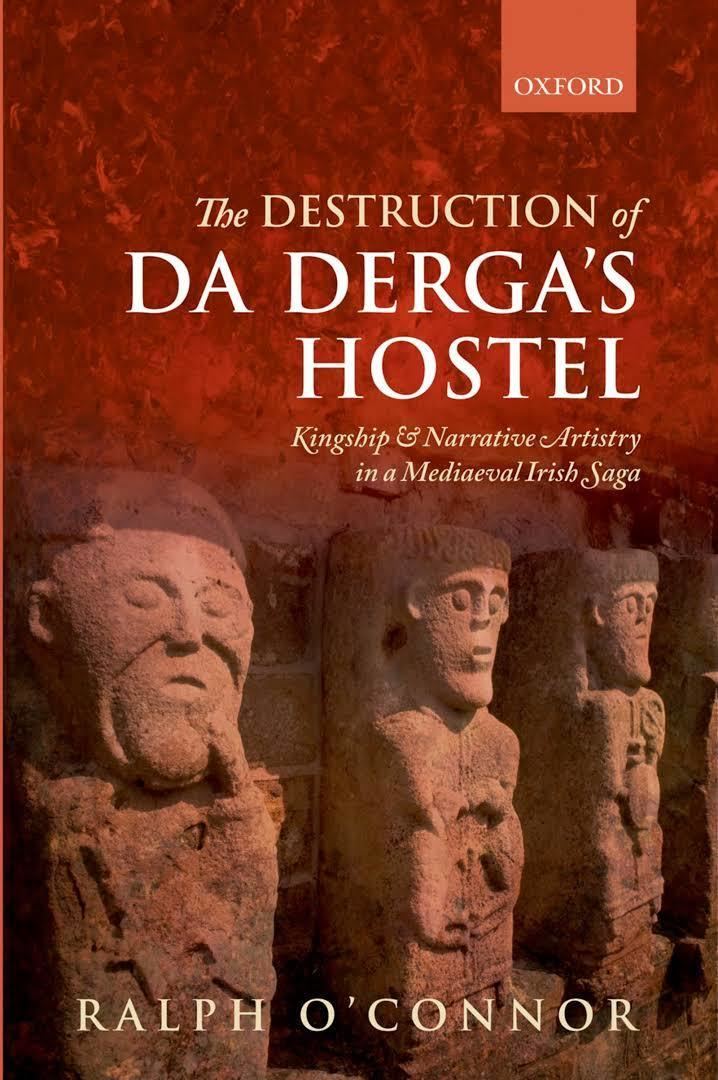Originally published 1936 | ||
 | ||
Also known as Orgain Bruidne Uí Dergae (first recension) Manuscript(s) Three recensions:Recension I: RIA MS 23 N 10; BL MS Egerton 88; NLI MS G 7; TCD MS H 3.18; Lebor na hUidreRecension II: Yellow Book of Lecan; RIA MS D IV 2; Lebor na hUidre; BL Additional 33993; BL MS Egerton 1782; BL MS Egerton 92; Book of Fermoy; TCD MS H 2.17; TCD MS H 3.18Recension III: BL MS Egerton 1782; TCD MS H.1.14. Personages protagonists: Conaire Mór son of Eterscél, Da Derga, Mac Cécht, Conall Cernach, Ingcél Cáech, sons of Dond Désa; Lé Fer Flaith, son of Conaire; etc. Similar Táin Bó Cúailnge, Book of Leinster, The Voyage of Bran, Lebor Gabála Érenn, Acallam na Senórach | ||
Togail Bruidne Dá Derga (The Destruction of Da Derga's Hostel) is an Irish tale belonging to the Ulster Cycle of Irish mythology. It survives in three Old and Middle Irish recensions. It recounts the birth, life, and death of Conaire Mór son of Eterscél Mór, a legendary High King of Ireland, who is killed at Da Derga's hostel by his enemies when he breaks his geasa. It is considered one of the finest Irish sagas of the early period, comparable to the better-known Táin Bó Cúailnge.
Contents
- Summary
- Manuscript tradition
- Recension I
- Recension II
- Recension III
- Related tales
- Influence
- Secondary literature
- References
The theme of gathering doom, as the king is forced through circumstances to break one after another of his taboos, is non-Christian in essence, and no Christian interpretations are laid upon the marvels that it relates. In its repetitions and verbal formulas the poem retains the qualities of oral transmission. The tone of the work has been compared with Greek tragedy.
Summary
After Conaire Mór has already broken several of his taboos, he travels south along the coast of Ireland He is advised to stay the night at Da Derga's Hostel, but as he approaches it, he sees three men dressed in red riding red horses arriving before him. He realises that three red men have preceded him into the house of a red man (as Dá Derga means "Red God"), and another of his geasa has been broken. His three foster-brothers, the three sons of Dond Désa, whom Conaire had exiled to Alba (Britain) for their crimes, had made alliance with the king of the Britons, Ingcél Cáech, and they were marauding across Ireland with a large band of followers. They attack Da Derga's Hostel. Three times they attempt to burn it down, and three times the fire is put out. Conaire, protected by his champion Mac Cécht and the Ulster hero Conall Cernach, kills six hundred before he reaches his weapons, and a further six hundred with his weapons. He asks for a drink as he is cursed with a magical thirst, but all the water has been used to put out the fires. Mac Cécht travels across Ireland with Conaire's cup, but none of the rivers will give him water. He returns with a cup of water just in time to see two men cutting Conaire's head off. He kills both of them. Conaire's severed head drinks the water and recites a poem praising Mac Cécht. The battle rages for three more days. Mac Cécht is killed, but Conall Cernach escapes.
Manuscript tradition
The tale exists in three recensions:
Recension I
Recension I is the earliest version of the saga, which briefly summarises the main events of the narrative. It is alternatively known as Orgain Bruidne Uí Dergae (The Massacre of Ua Derga's Hostel), the title given in Lebor na hUidre, to keep it distinct from the later recensions.
Recension II
Recension II, a composite text, is the most famous version of the tale. On the basis of a number of contradictions, inconsistencies and duplicates in the tale, scholars such as Heinrich Zimmer, Max Nettlau and Rudolf Thurneysen suggested, each in his own way, that the recension represents a conflation of two, possibly three, variant sources. However, Máire West has pointed out the weaknesses inherent to their approach and instead favours the more flexible view that the author drew from a greater variety of written and oral sources.
Recension III
The youngest and longest version is represented by Recension III, to which further materials have been added, including a king-list, a version of Tochmarc Étaine and further dindsenchas lore.
The translation by J. Gantz, in Early Irish Myths and Sagas (1986) has an introduction that discusses its probable relationship to a king's ritual death, more fully explored by John Grigsby, Beowulf and Grendel 2005:150-52.
Related tales
A related tale is De Sil Chonairi Móir.
Influence
It has been argued that Geoffrey Chaucer's The House of Fame borrows features from the Togail Bruidne Da Derga.
